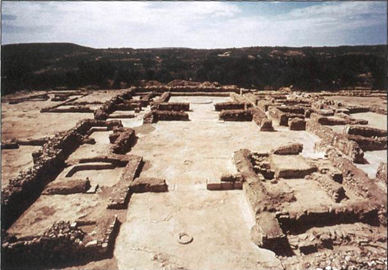Architecture
Wood was freely used in all parts of the construction of the palace, even the stone walls being erected within a massive framework of large horizontal and vertical timbers.

Figure 3. Main Building from the southeast
Wood was freely used in all parts of the construction of the palace, even the stone walls being erected within a massive framework of large horizontal and vertical timbers.
Columns, door-casings, wainscoting, ceilings, and roofs were also constructed mainly of wood, and this abundance of combustible material accounts for the devastating effect of the fire that destroyed the palace. The exterior walls on all sides were built with an outer facing of fine squared blocks of limestone (poros) laid in neat rows with the outside facing smoothed off, while rubble was used for the inner facing. The interior walls were constructed mainly of rub¬ble, though large stones and squared blocks were often used there too. The faces of the interior walls were coated with plaster, and those in all important rooms were decorated with frescoes.
The Main and Southwestern buildings were two-storied, each having stairways leading to the upper floor. The latter evidently had walls built of rude brick laid in the usual framework of wooden beams. The roof was probably formed by flat terraces, perhaps in two or more levels. The roof over the throne room (6) was certainly higher than that on each side.